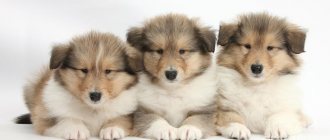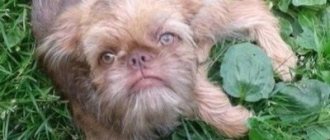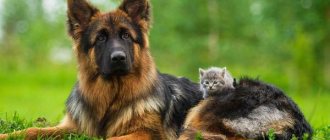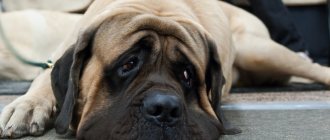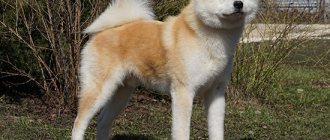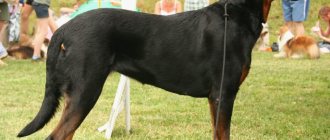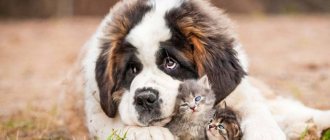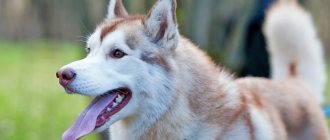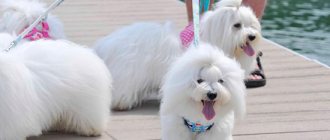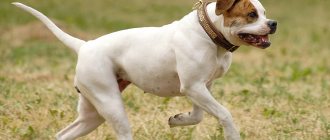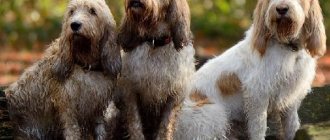The Drathaar is a breed of hunting pointing dog bred in the mid-19th century in Germany and then spreading first across Europe and then throughout the world. Currently, the Drahthaar, along with the Shorthaired Pointer, is the most popular and most common breed of hunting dog in our country. The drathaar's closest relatives are the shorthaired pointer and the langhaar. Let's tell you more about this wonderful breed of dog.
Video
* We invite you to watch a video about the Drathaar . In fact, in front of you is a playlist in which you can select and watch any of 20 videos about a given dog breed by simply clicking on the button in the upper right corner of the window. In addition, the material contains quite a lot of photos. By looking at them you can find out what Drathaar looks like.
In this article:
|
Rate the material!
[Total votes: 1 Average: 4]
The Drathaar (German Wirehaired Pointer) is the best friend of an ardent hunter. The breed is distinguished by its versatility, and has also proven itself excellent in hunting both small and large game. The appearance of this dog is very recognizable and courageous. Drathaars are literally “furry energizers” who handle different types of game with enviable dexterity and endlessly love their owner. On top of that, they have an excellent character, a sharp mind and almost never show aggression towards humans.
History of the origin of the drathaars
Drathaar is a “product” of many years of work by German breeders. This is hinted at by the very name of the breed, which translated from German means “wire hair.” The history of the breed began in the middle of the 19th century. Dog breeders and breeders in Germany came up with the idea of bringing a new variety of pointer, which would combine the best working qualities of its predecessors.
Interesting fact: Considerable requirements were put forward for the “future model”: it had to be hardy, with excellent sense of smell and hearing, and be good at hunting both field and swamp game.
After a large number of experimental matings, breeders finally managed to obtain a generation of hunting dogs that meet all the above requirements and have hard and coarse hair.
The following breeds of hunting dogs were used as the initial genetic material: pointer poodles, Korthals griffons, and Stichelhaars. Experience shows that crossing representatives of these very breeds has made drathaars ideal hunters, capable of working even in bad weather.
Draathars received public recognition quite quickly - in the 70s of the 19th century, and already in 1902, the first specialized club was founded in Germany. A couple of decades later, this breed was included in the register of the International Canine Federation. Surprisingly, in such a short time the breed managed to gain popularity in most countries of Western Europe, including the very conservative Great Britain.
As for the New World, drathaars did not immediately gain recognition there, since the Americans, accustomed to using exclusively highly specialized dogs in hunting, had long been distrustful of the new breed.
Choosing a puppy and price
Drathaars are a very popular and widespread breed among domestic hunters. This is eloquently evidenced by the number of dogs at exhibitions and trials. Unfortunately, this only complicates the process of choosing a good puppy. In recent years, dogs from European countries have often been brought to Russia; many believe that a German pedigree will automatically open the door to selection. But along with dogs from good kennels, they also bring outright rejects.
If it is customary to buy a dog abroad, you need to choose a kennel that has been working with the breed for decades, and its producers take part and earn good points in the “Hegewald” - a complex testing system developed by the Germans for cops. They also pay attention to their assessment of their exterior. The whole procedure is quite complex, lengthy and troublesome. Dogs are often purchased abroad by people who intend to start breeding.
If you need a dog as a friend and hunting assistant, you can limit yourself to searching and purchasing a good puppy in your homeland. The puppy’s parents must have an exterior grade of at least “Excellent”, as well as at least two diplomas: in field and swamp game. Additional blood trail and duck are highly desirable. The higher the degree obtained in competitions, the better and more likely the children are to inherit talents. Abroad, it is customary to sell puppies no earlier than 3.5 months; at this age, the most promising babies can already be identified. This is rarely practiced in our country; puppies are given away at the age of 1.5-2 months, and even breed experts are not always able to choose the best one.
You should not buy puppies at a poultry market or from online advertisements with photos, even if the price seems very attractive. Puppies from good litters are usually sold by reservation, but it is better to wait in line than to then suffer with a dog of dubious origin.
The price of a Drahthaar puppy varies widely, since it is influenced by many factors: the merits of the parents, the status of the breeder/kennel, its location. On average, a good puppy costs 20,000-25,000 rubles. Grown-up, well-proven dogs are sometimes sold for much more. According to advertisements on the Internet, a puppy can be found for 10,000-15,000 rubles.
Drathaar - description of the breed
The drathaar has a very harmonious and expressive appearance. However, this breed is not valuable for its appearance alone, therefore, to obtain an expert assessment, each individual must go through field trials. By breed standards, the Draathar is a fairly tall and strong dog of a somewhat square format, weighing 23-32 kg.
Height at withers:
- Males - up to 68 cm;
- Females - up to 64 cm.
The dog's head is quite large, somewhat square. The characteristic appearance of the head is provided by a mustache, beard and pronounced eyebrow arches. The dog's eyes are usually dark with a specific, demanding and attentive gaze.
The entire body of the dog, starting from the neck, is quite wide and muscular. The chest is voluminous, oval in shape. The tail is set horizontally. All four legs of the draathar are quite strong, well padded and muscular. The animal's movements are sweeping and smooth, and the dog usually runs with its head held high.
The coat on different parts of the dog's body has different lengths (2-4 cm). There is definitely a “beard” on the muzzle, and the groin and belly are more overgrown with hair. The structure of the coat is dense (undercoat) and hard (guard hairs).
According to the VDD rules, the appearance of each individual of the Draathar breed is assessed based on only two parameters: coat and shape. The maximum score is 12 points for each parameter. Dogs with scores of 10/10 are recommended for breeding, with the minimum score for such admission being 6/6.
Important fact: Even with the highest scores, a drathaar can be disqualified if he does not show any hunting ability and is very scared of a shot from a gun.
Defects in the appearance of a draathar that usually prevent exhibition specimens from receiving high scores:
- Lack of teeth;
- Muzzle that is too short or too pointed;
- Sparse coat with sparse undercoat;
- Drooping eyelids;
- Humpback;
- Crooked limbs;
- Wrong gait.
As for complete disqualification, animals with too obvious developmental defects fall under it:
- Malocclusion;
- Jaw distortion;
- Different eye colors;
- Wrong color;
- Entropy;
- Tail break.
Main indicators of the breed standard
Basically, the average sizes of drakhtaars are as follows:
- the height of males is approximately sixty-eight centimeters, the height of females is sixty-three centimeters;
- The weight of males is thirty-two kilograms, the weight of females is twenty-seven kilograms, respectively.
The color characteristic of wire-haired Drakhtaars in most cases comes down to brown or black speckling, and the presence of various spots or inclusions is also very often observed.
It is also necessary to pay attention to the following features of such an animal as the Drathaar hunting dog:
- The eyes are particularly attentive and their color is usually dark.
- The nose is the same color as the coat, but it is brighter and more intensely pigmented.
- The Drathaar description provides that the pet's body has clear contours that are not hidden under the cover of long, heavy fur. Although the weight of the coat can be quite significant.
- The dog's head is completely combined and in harmony with the entire body, the muzzle is quite elongated. As for the muzzle, this unusual breed of dog has thick shaggy eyebrows and a peculiar beard.
- The animal's ears have a certain hanging shape and are also very high.
- If the dog is hunting, then it is best to dock its tail. However, you can also leave it in its original form, which may cause some inconvenience for animals when they hunt in winter. Hunting with a drathaar is an indescribable pleasure.
- The animal's fur is very durable, and the undercoat is somewhat waterproof, which in some cases definitely complicates how I keep my pet.
Thus, we can summarize that the Drathaar breed standard provides for a powerful, beautiful animal, which is distinguished by thick, coarse hair and pronounced body features. However, keeping a drathaar can be complicated due to the fact that the dog's coat is very thick and dense, which can cause a lot of difficulties during the bathing process.
Popular colors of drathaars
The drathaar's coat is a fairly dense coat, consisting of hard “wirey” main hairs and a very thick waterproof undercoat. This coat can protect dogs from accidental injuries during hunting and bad weather. As mentioned above, the length of fur in different parts of the dog’s body can be different.
This means that the hair on the head, ears and belly is shorter (2 cm), and in other places it is longer (4 cm). In addition, on the animal’s face the fur forms a rather expressive “beard” and “eyebrows” - distinctive features characteristic only of this breed.
Dense speckled colors of brown and black tones are very typical for the drathaar, occasionally supplemented by blurry spots, usually located on the sides. Rarely speckled color variants and brown variants are also allowed. Moreover, it is quite common for pure brown dogs to have a noticeable longitudinal white marking on the chest - a “tie”.
The most common colors of drathaars are:
- Brown-gray with spots;
- Brown-gray without spots;
- Black and gray with spots;
- Black-gray without spots;
- Uniform brown;
- Uniform brown with a white patch ("tie") in the chest area;
- Gray.
It is worth noting that the British usually mercilessly reject individuals with a white spot on the chest and under no circumstances allow them to enter exhibitions, because, according to the English standard, such an addition to the color is considered unacceptable. Even if a dog is a three-time excellent hunter, if he has a “tie”, his path to breeding and receiving high awards in Great Britain is cut off forever.
Character and habits of drathaars
When thinking about purchasing a Drahthaar puppy, it is important for its future owner to understand that these dogs are only 20% pets, while the remaining 80% are hunters to the core. For this reason, they, like true hunters, are ready to wander around forests, fields, meadows or swamps all day long in search of the treasured trophy.
First of all, the breed is driven by hunting instincts. If a pet is deprived of the opportunity to run after game or even a mouse, it will turn into a sad shadow of a cheerful dog. So for those who do not like hunting, there is no point in acquiring a drathaar.
The character of these hunting dogs is non-aggressive, but they are quite suspicious and distrustful of strangers, so sometimes they can make good watchdogs. Drathhaars also make excellent companions. These dogs also do not offend children; they are very willing to play a variety of active games with them. So, if it is not possible to take the Dratthaar for a walk, you can, as an exception, leave him with the kids for an hour.
The main character traits of the drathaar:
- Mind;
- Responsibility;
- Performance;
- Friendliness;
- Craving for dominance.
The last item on the list may cause misunderstandings between the owner and the dog. So, if his owner has an overly flexible character, the dog will not at all mind turning him into the fulfillment of his desires.
As for training, raising this breed is no more difficult than any other. An important point: these good-natured cops require a serious mentor who will not only not allow himself to be manipulated, but will also not be overly strict.
Advantages and disadvantages
Advantages of drathaar
The Drathaar, as a breed, has serious advantages that have made this dog breed so popular both in our country and throughout the world:
- The Drathaar is a versatile pointing hunting dog that can be used to hunt a wide variety of game species, from quail and snipe to wild boar and elk. With a drathaar you can hunt swamp-meadow, field, pine forest, waterfowl, and also use it for animal hunting.
- A serious advantage of drathaars is their dense, waterproof wool. The coat protects the dog like chain mail; thanks to its coat, the drathaar is not afraid of cold, water, thorns, thorns, sharp branches and insects. The length of the hair along the body of the drathaar reaches 3-6 cm, the stomach, chest, and back are well protected. The shoulders and thighs are covered with longer hair. Even on the ears and crown, the length of the hair reaches 1.5 cm in length. In addition, the dog's entire body is covered with soft and thick undercoat, which becomes thicker in cold weather and when kept outside.
- Drathaar has excellent physical characteristics, great endurance, good intellectual abilities, and is easy to train and train.
- Drathaars have a balanced type of nervous system, thanks to which they are easily controlled; unwanted excited actions can be easily inhibited. All this makes the Drathaar a dog easy to train and easy to live in the house.
Disadvantages of drathaar
With all the advantages of the drathaar, they also have some disadvantages:
- Drathaar loves to be in charge, wants to dominate and control his territory. Due to its tendency to dominate, the owner of the Drathaar must be a strong-willed person with a strong character, capable of establishing and maintaining his leadership over the dog, otherwise the Drathaar will get out of control.
- The Drathaar is a dog that needs serious physical exercise, otherwise it will expend its energy in undesirable ways. If you are not ready to provide your Drathaar with long, long walks, it is better not to get such a dog.
- Drathaar has a suspicious attitude towards strangers, which can easily turn into aggression. It is not worthwhile to develop the guarding and protective instinct in a drathaar too much, as this can lead to a distortion in the dog’s psyche and dangerous behavior of the dog towards others.
Interesting facts about drathaars
Drahthaars are very common in the United States, as well as in northern and central European countries. Today, approximately 40% of all hunting dogs in Germany are bearded hunters.
There is an opinion that these dogs can be guards in a private home. Of course, due to imperfect selection, the character of drathaars may change, but in Germany the use of drathaars as guards is usually suppressed.
Dogs of this breed, living in their own fenced area, are not at all averse to barking loudly at passers-by. At the same time, the courageous appearance visible from behind the fence usually makes an indelible impression on people. When kept in apartments and regularly walked along city streets, dogs behave much calmer and friendlier.
Conflicts between male drathaars are not uncommon, but rather the norm. The reason for this behavior is that all males of this breed are prone to dominance, not only over their own kind, but also over their owners. By the way, the rather cool disposition of most males is more than compensated by their reliability during hunting.
Despite their rather masculine appearance, drathaars are very friendly, both with adults and children.
Despite their energy and some insolence, drathaars often establish a literally spiritual connection with their owners, which, after several joint hunting seasons, often transforms into the so-called “collective mind.”
Thanks to its hard and dense coat, the drathaar feels quite comfortable not only in the rain, but also in fairly severe frost.
Pros and cons of drathaars
The Drathaar dog is simply a unique find for a hunting enthusiast.
The breed has a considerable list of advantages, which can be much more:
- Versatility;
- Adaptation to adverse natural and weather conditions;
- High efficiency;
- Endurance;
- Lively mind;
- Strength, passion, determination, reliability;
- Mobility;
- Friendliness.
As mentioned above, the list of advantages of the drathaar can be expanded even more, but under one condition: the owner of the dog must be an experienced hunter with many years of practice and ready to invest time and money in his four-legged assistant. After all, these dogs are absolutely not created for an idle and quiet life - give them a hunt. Moreover, the more often this happens, the better.
If for some reason the condition is not met, then the drathaar often has disadvantages:
- Excessive mobility and activity;
- Assertiveness;
- Curiosity;
- The need for constant monitoring;
- Lack of delicacy;
- Manifestation of a tendency to dominate.
It is important for the future owner of the Drathaar to understand that training this dog is not easy and simple, and truly good hunting training is a very rare and expensive service.
According to the majority of regularly practicing hunters, representatives of this breed, it is better to start teaching hunting by training only one type of prey. In the homeland of the drathaars, in Germany, they do not agree with this and train cops to work with several varieties of game at once.
Since these dogs have a genetic passion for hunting, they can often catch game without even undergoing a special training course. For example, drathaars living in the private sector often bring “gifts” to their owners in the form of mice, hamsters, squirrels or rats.
Care and maintenance
The pointer is not particularly whimsical; she can live in any home environment, as well as in a spacious enclosure. If a dog spends most of its time outdoors, it will develop a thicker undercoat. For a comfortable stay, all she needs is her own bed, a bowl of food and water. In addition, you can pamper her with several toys. Such a pet will never sleep in bed with you and will not touch your favorite sofa; the dog does not need frills, clothes and other dog trifles.
The rather thick and complex coat of the pointer needs periodic care. As a rule, it cleans itself, so the pet always looks good and tidy. It should be washed several times a year or as needed.
Drahthaar Breeding
Since the Drathaar is one of the most famous cops in the world, active work is constantly being carried out with this breed on breeding and improving all existing qualities.
Drahthaars are bred by both nurseries and private owners. However, there are many peculiarities in this process, in particular, a rather careful selection of pairs based on color. This is done due to the fact that in some color combinations there is a high probability of offspring with non-standard colors. Another important criterion for assessing the breeding value of drathaar sires is the presence of working qualities and the ability to transmit them to offspring.
Dogs in kennels are usually kept in enclosures all year round, but always with an insulated kennel. This is possible thanks to their dense and thick coat. The only exceptions to the rule are pregnant females and small puppies, which must be kept in a relatively warm room for a certain period.
It is worth noting that constant exposure to the street, regular physical activity, and proper nutrition have a good effect on the general health and appearance of dogs. All breeding draathars in the nursery must be vaccinated annually and tested for a number of diseases.
Such as:
- Dysplasia of the elbow and hip joints;
- Willeband's disease;
- Osteochondritis dissecans of the shoulder joints.
Selecting future couples in nurseries is not an easy procedure with a whole range of mandatory characteristics and taking into account the advantages and disadvantages of both partners. As a rule, the breeding male should be somewhat superior to the female in quality.
After all of the above, is it necessary to say that in all respects it is better to purchase a Drahthaar puppy from a specialized nursery than from a private breeder?
Features of training and education
When choosing and purchasing a Drahthaar puppy, you must definitely study the puppy’s pedigree and make sure that the puppy’s ancestors have working diplomas. It is better to involve a specialist in studying the puppy’s documents, who can check the information contained there through his own channels. It will be very good if you watch the puppy’s parents at work, either on a real hunt or in field trials.
It will be better if a professional trainer does the training of the drathaar; it is even better if you do it yourself, but under the supervision of an experienced trainer.
Any Drathaar training begins with establishing close contact and trust between the dog and its owner.
The Drathaar is a very energetic, active and agile dog; before starting training with the Drathaar, you need to give him the opportunity to throw out excess energy and only after that begin training.
Drathaar perfectly senses the owner’s mood, which is transmitted to the dog; if you are tired or irritated, then it is better not to train the dog at all on this day, nothing good will come of it anyway.
An overly strict punishment or a long, tedious drill can put the drathaar into the state of “I don’t hear anything, I don’t understand anything, I can’t do anything.” Don't let your dog get into this state.
Drathaar must understand his position in the pack, sometimes he can try to become the leader of the pack, such attempts must be immediately suppressed.
Punishment of a drathaar should first of all be verbal, with the correct intonation. Mechanical impact (pressing the dog to the ground, pulling the leash) is acceptable in extreme cases. There is no need to hit the drathaar.
Drathaar training should be done by a professional who knows the specifics of training continental cops. The best option is when the dog owner himself does the training under the guidance of an experienced trainer. Incorrect training can very quickly ruin even a good dog.
Caring for Drahthaars
The Drathaar is a fairly unpretentious breed. A dog can live either in a house or apartment, or in an enclosure. She is also not particularly picky about food. You can bathe your dog with shampoo 2-3 times a year, or you can not do it at all. As for the claws, most often their trimming is not required for the simple reason that they grind down on their own.
If the dog's owner is a great esthete, then caring for it can be made more civilized. For example, do regular examinations of the ears, eyes, paw pads, partitions between the toes, and strengthen antiparasitic measures to prevent infection by helminths and ticks. You can also constantly monitor the appearance of the coat. This is especially true during the molting period or if the dog regularly takes part in exhibitions.
It is important to understand that the structure and thickness of the coat varies among different representatives of the breed, which, in fact, determines the severity of shedding. For the animal's coarse and long fur, regular brushing is necessary. If this is not done, then excess undercoat may form, and the guard hair will not fall out completely during the molting process. It is highly advisable to trim the hair on the head of puppies and juniors that is too soft before the age of one year. The same applies to too long hair, because it will greatly interfere with hunting.
Drathaars are not at all afraid of water and love to swim in bodies of water, so you should not deprive them of this opportunity, since a constant excess of energy requires an outlet. Dogs also love to engage in any sport: running, jumping, playing catch.
How to choose the right puppy?
Choosing a Drahthaar puppy is not as simple as it might seem at first glance. Due to the fact that the breed is not well known, it is not so easy to find a truly purebred bearded baby. This is unlikely to be found on the market, and it’s not worth buying there.
It is best to visit the exhibition first. If representatives of this breed are not there, then you can ask other breeders who are breeding them. Having found the right nursery, take the trouble to check the parents’ documents and also make sure of their authenticity. Do not hesitate to ask for test results, check award diplomas. If you need a puppy for hunting, then it is advisable to watch the parents at work, then there will be a better chance of buying exactly what you need.
Appearance also matters. Quite often, the puppy in the photo does not correspond to reality, so it is best to meet your future four-legged friend in person. If you have any problems while choosing, please contact a specialist for help. Price: 200-1000 USD
Diet of drathaars
Experience shows that drathaars are not particularly picky when it comes to food. So the dog owner always has a choice of what food to feed his pet: special dog food or natural products. The main thing here is that the diet is well balanced. It is worth noting that drathaars are not prone to food allergies.
When feeding your four-legged friend with natural products, it is important to consider that in order to maintain high physical activity, high-protein foods must be present in his diet. It follows from this that the daily menu of the drathaar should consist of one third of porridge, vegetables, fruits and two thirds of not too fatty meat and offal. The best vegetables and fruits to give to animals are: pears, apples, carrots, greens, zucchini, pumpkin. From protein products: meat and offal, fish, kefir, cottage cheese, eggs. At the same time, it is very important not to overfeed the dog and be sure to monitor its weight.
Fun fact: A healthy adult drathaar should weigh no more than 32 kg. The amount of food that a dog should receive at one time depends on the conditions of detention and stress. So it turns out that a dog that is kept outside in an enclosure should receive a little more food than one that lives in an apartment or house.
It’s interesting, but domestic dog breeders prefer to feed drathaars “naturally”, while Europeans are more inclined to feed them dry food. Well, to each, as they say, his own. When choosing dry food, it is important to focus not only on its manufacturer and class, but also on the percentage of protein content, which should not be lower than 30%. Sometimes owners also practice a mixed feeding method. According to professionals, this option cannot be called ideal, so it is widely criticized.
How much do German Drahthaar puppies cost?
How much a drathaar puppy costs depends on the nursery, the pedigree of the parents, and the number of exhibition regalia:
- the price of a pet-class pet is 5 thousand rubles;
- the cost of breed-class dogs is 10-20 thousand rubles;
- show-class animals will cost more – from 25 thousand rubles.
Puppies from the nursery https://animavenator.com.ua
Adult, trained wire-haired pointers cost from 50 to 200 thousand rubles.
Diseases and health problems
Natural endurance, inherent at the genetic level and an active lifestyle, cannot insure German wire-haired pointers one hundred percent, therefore, although quite rarely, they still get sick. At the same time, most cynologists and the VDD breed club are still inclined to believe that, in general, the genetics of the Drahthaar are quite healthy.
It is important for owners of such dogs to know that the causes of most diseases in their pets are:
- High physical activity;
- Features of practical application;
- Temperament;
- Large size;
- Skeletal structure;
- The structure of wool.
List of the most common drathaar diseases:
- Hip dysplasia;
- Osteochondritis of the shoulder joints (dissecting);
- Volvulus;
- Gastric volvulus;
- Eczema;
- Dermatitis;
- Eye pathologies (inflammations);
- Otitis.
A separate problem for these dogs is quite frequent cuts to the nose, muzzle, paw pads, as well as snake bites and poisonous insect bites during hunting. After all, an animal in the excitement of the hunt rushes into the most impenetrable thickets, not noticing anyone or anything around it.
It is important for the owner of the drathaar to keep in mind that these dogs tolerate cold and slush much better than heat and exposure to direct sunlight. Therefore, in the summer it is important to provide your four-legged friend with shelter from the sun and access to clean water. Also, because of their love of swimming, especially in the off-season, when the water in reservoirs is very cold, drathaars, through their stupidity, can become seriously hypothermic and even contract pneumonia.
A representative of this breed who eats well and is moderately active can usually live up to 13-14 years, and take part in hunting up to 10 years.
Application
Drathaar is a hunting dog with an excellent sense of smell and acute hearing. With proper upbringing, your pet can turn out to be a first-class watchman or security guard.
Modern German cops take part in competitions in:
- ski joring;
- bike joring;
- dryland.
Drathaars are often recruited to serve in the Ministry of Emergency Situations.
